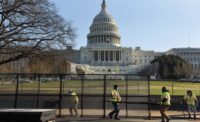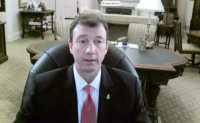The acting chief of the U.S. Capitol Police called for permanent fencing around the U.S. Capitol in response to the deadly Jan. 6 riot on Capitol Hill.
Yogananda Pittman also called for other enhanced security measures around the Capitol in a Jan. 28 statement released the same day Capitol Police arrested an armed 71-year-old West Virginia man near the building who had 20 rounds of ammunition, according to media reports.
“In light of recent events, I can unequivocally say that vast improvements to the physical security infrastructure must be made to include permanent fencing, and the availability of ready, back-up forces in close proximity to the Capitol,” Pittman said in the statement. She added, “I look forward to working with Congress on identifying the security improvements necessary to ensure the safety and security of the Congress and the U.S. Capitol.”
Several building security experts interviewed by ENR immediately after Jan. 6 asserted that permanent security measures around the Capitol Complex should balance safety and accessibility to the nation’s most visible symbol of democracy.
“The building didn’t fail: the security response failed,” said Thomas Vonier, a Washington, D.C., and Paris-based-architect who is also the president of the International Union of Architects and past president of the American Institute of Architects.
Lawmakers on both sides of the aisle echoed Vonier.
“This is the People's House. I am adamantly opposed,” Rep. Elise Stefanik (R-N.Y.) tweeted in reference of the permanent fencing, after Pittman released her statement. “There has been no threat briefing given to Members of Congress to justify this proposal.”
Washington, D.C., Mayor Muriel Bowser tweeted that extra temporary security measures are needed for “some potentially volatile events upcoming," but she will not accept "permanent fencing as a long-term fixture in D.C. When the time is right, the fencing around the White House and U.S. Capitol, just like the plywood we've seen on our businesses for too long, will be taken down.”
Temporary fencing was installed around the Complex the day after supporters of President Donald Trump stormed the Capitol Building.
Higher levels of security around the Capitol have been called for throughout the last few decades. Pittman said security experts argued for more permanent protection at the U.S. Capitol after the Sept. 11 terrorist attacks. “In fact, a 2006 security assessment specifically recommended the installation of a permanent perimeter fence around the Capitol,” she noted.
After being named acting chief on Jan. 8, Pittman ordered her staff to conduct a physical security assessment of the Capitol Complex. The Capitol Police's Inspector General, along with a third-party, are also reviewing the Complex’s “physical infrastructure, processes and command and control,” according to Pittman.
She added, “I welcome each of these reviews, and I am ensuring that the Dept. will provide all of the information that is necessary to facilitate these studies. In the end, we all have the same goal—to prevent what occurred on Jan. 6 from ever happening again.”






Post a comment to this article
Report Abusive Comment